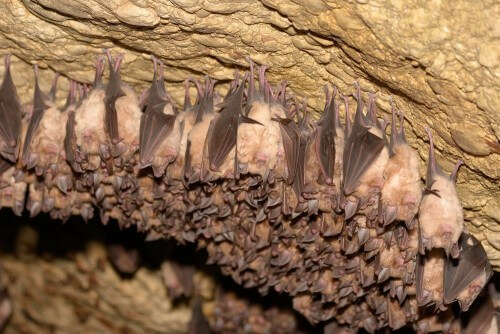The impressive and unique navigation ability of the bat is an inspiration for the development of advanced technological guiding sticks for the blind

Although the bat is not completely blind, it finds its way in the dark mainly through "echolocation". It sends ultrasonic sound waves (which are not within the range of human hearing) towards the object or the animal that returns to it and these allow it to know the size of the object, its characteristics and its distance from it. By multiplying time times the speed of sound, you can tell what the distance is. This method allows a distance with an accuracy of less than a millimeter and an accuracy of between 1-2 degrees of the angle from which the sound comes. A person, for comparison, when trying to gauge the distance of an approaching car reaches an accuracy level of between a meter and tens of meters.
A bat changes its frequency according to the environment in which it is found. Low frequency has longer waves and can be heard in the distance. Such a frequency is suitable for an environment that is not complicated. Using a high frequency allows for a more continuous and more detailed sampling of the space. A fruit bat did not need detailed information and therefore its frequencies will be mostly low. An insect bat needs continuous and high-quality information to hunt the nocturnal insects, so its frequencies will be high.
The question arises, how does the bat deal with navigating in a dense area with a lot of background noise? Imagine yourself at a cocktail party where there is a lot of background noise of people talking and you are trying to focus on listening to a certain person who is talking to you. Researchers at Tel Aviv University led by Prof. Yossi Yuval, found that while flying, the bat changes the opening of its mouth, which varies between wide and narrow, thus controlling the width of the ultrasonic beam that provides it with information.
Inspired by the bat, Dr Amir Amadi From the Israel-Canada Medical Research Institute and the Safra Center for Neuroscience at the Hebrew University, a virtual walking stick for the blind. The "smart" guide stick helps many blind people to navigate space more easily. The simple guide stick does not allow a blind person to know that he has reached an object until he actually encounters it. It also did not prevent malfunctions with objects that are not on the ground (such as tree branches). The electronic stick sends a focused and precise beam towards the objects in its vicinity. It works similar to how bats and dolphins send a signal and receive its return to learn about their location. The stick, which is the size of a cell phone, translates the distance into a light vibration of varying intensities.
Another guide stick that uses the same inspiration of dolphins and bats goes by the name Ultra Cane. The electronic cane helps the blind to know what is happening around him by feeling a vibration in his palm holding the cane. The stick alerts as soon as its sensors detect an obstacle within their detection range. The closer you get to the obstacle, the faster the blind person feels a vibration in his hand. The stick has two distance ranges: short - up to a range of 2 meters. Long - up to a range of 4 meters. The upper sensor detects up to a range of 1.6 meters. The development of the electronic cane allows freedom in walking, faster, safer and more efficient walking. The development of this stick relied on the brain's flexible ability to "see". The information received from the stick is transmitted to the brain and processed exactly in the same part responsible for visual processing. The flexible brain is amazingly and surprisingly able to adapt to different sensory processing than it is used to. The development of this means of "sight" allowed a blind man to ride his bicycle for the first time on a narrow path in a tangled forest without encountering any obstacles.
In conclusion, we can say that we see with our brain no less than with our eyes. The advanced developments actually bypass the problem with the eyes and rely on the ability of the flexible brain to adapt itself to new roles.
